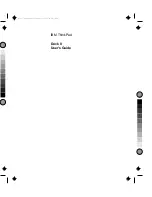
263
Glossary
5.375 x 8.375 ver 2.3
compatibility
— The extent to which computers, programs, or devices
can work together harmoniously, using the same commands,
formats, or language as another.
configuration
— (1) The collection of components that make up a single
computer system. (2) How parts of the system are set up (that is,
configured).
controller
— A device that controls the transfer of data from a computer
to a peripheral device and vice versa. For example, disk drives,
monitors, keyboards, and printers all require controllers.
CPU
— See
central processing unit (CPU).
CPU cache
— A section of very fast memory residing between the CPU
and the computer’s main memory that temporarily stores data and
instructions the CPU will need to execute commands and programs.
See also
cache, L1 cache, L2 cache.
cursor
— A symbol that indicates the current position on the screen. The
shape of the cursor varies, depending on the program you’re using
and what you’re doing.
D
default
— The setting selected by a program when the user does not
specify an alternative setting.
device
— A component attached to the computer. Devices may be
external (outside the computer’s case) or internal (inside the
computer’s case). Printers, disk drives, and modems are examples of
devices.
device driver
— A program (called a “driver”) that permits a computer
to communicate with a device.
dialog box
— An on-screen window displayed by the operating system
or a program giving a direction or requesting input from the user.
direct current (DC)
— The type of power usually supplied by batteries.
DC flows in one direction. Compare
alternating current (AC).
direct memory access (DMA)
— A dedicated channel, bypassing the
CPU, that enables direct data transfer between memory and a
device.
directory
— See
folder
.
Summary of Contents for Satellite P25 Series
Page 282: ...282 5 375 x 8 375 ver 2 3 ...
















































